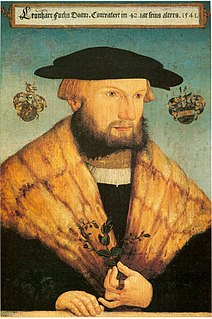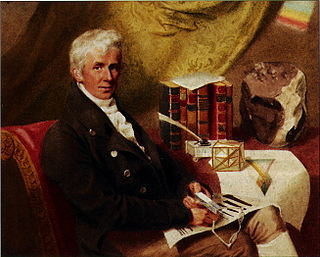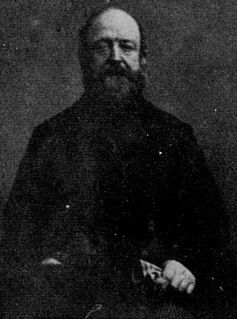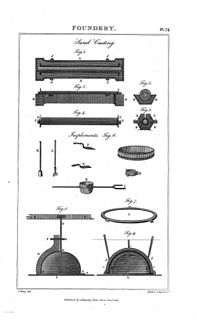
John Gould FRS was an English ornithologist and bird artist. He published a number of monographs on birds, illustrated by plates that he produced with the assistance of his wife, Elizabeth Gould, and several other artists including Edward Lear, Henry Constantine Richter, Joseph Wolf and William Matthew Hart. He has been considered the father of bird study in Australia and the Gould League in Australia is named after him. His identification of the birds now nicknamed "Darwin's finches" played a role in the inception of Darwin's theory of evolution by natural selection. Gould's work is referenced in Charles Darwin's book, On the Origin of Species.

George Edwards was an English naturalist and ornithologist, known as the "father of British ornithology".

Leonhart Fuchs[ˈfʊks], sometimes spelled Leonhard Fuchs, was a German physician and botanist. His chief notability is as the author of a large book about plants and their uses as medicines, i.e. a Herbal Book. It was first published in 1542 in Latin. It has about 500 accurate and detailed drawings of plants, which were printed from woodcuts. The drawings are the book's most notable advance on its predecessors. Although drawings were in use beforehand in other Herbal books, Fuchs' Herbal book proved and emphasized high-quality drawings as the most telling way to specify what a plant name stands for.

James Sowerby was an English naturalist, illustrator and mineralogist. Contributions to published works, such as A Specimen of the Botany of New Holland or English Botany, include his detailed and appealing plates. The use of vivid colour and accessible texts were intended to reach a widening audience in works of natural history.

James Francis Stephens was an English entomologist and naturalist. He is known for his 12 volume Illustrations of British Entomology (1846) and the Manual of British Beetles (1839).

Pantologia is an English encyclopedia, published in 12 volumes, 8vo in 1813, with 370 plates. Its full title page was A New Cyclopedia, comprehending a complete series of Essays, Treatises and Systems, alphabetically arranged, with a general dictionary of Arts, Sciences and Words: the whole representing a distinct Survey of Human Genius, Learning and Industry, illustrated with elegant engravings; those on Natural History being from original drawings by Edwards and others, and beautifully coloured after nature ...

Sydenham Teast Edwards was a natural history illustrator.

William Curtis was an English botanist and entomologist, who was born at Alton, Hampshire, site of the Curtis Museum.

John Lindley FRS was an English botanist, gardener and orchidologist.

Eugenius Johann Christoph Esper was a German entomologist. Born in Wunsiedel in Bavaria, he was professor of zoology at Erlangen university.

Henry Constantine Richter was an English zoological illustrator who produced a very large number of skillful coloured lithographs of birds and mammals, mainly for the scientific books of the renowned English 19th century ornithologist John Gould.

Henry John Elwes, FRS was a British botanist, entomologist, author, lepidopterist, collector and traveller who became renowned for collecting specimens of lilies during trips to the Himalaya and Korea. He was one of the first group of 60 people to receive the Victoria Medal of the Royal Horticultural Society in 1897. Author of Monograph of the Genus Lilium (1880), and The Trees of Great Britain & Ireland (1906–1913) with Augustine Henry, as well as numerous articles, he left a collection of 30,000 butterfly specimens to the Natural History Museum, including 11,370 specimens of Palaearctic butterflies.

The Botanical Magazine; or Flower-Garden Displayed, is an illustrated publication which began in 1787. The longest running botanical magazine, it is widely referred to by the subsequent name Curtis's Botanical Magazine.

John Stackhouse was an English botanist, primarily interested in Spermatophytes, algae and mycology. He was born in Probus, Cornwall and built Acton Castle, above Stackhouse Cove, Cornwall in order to further his studies in the propagation of algae from their spores. He was the author of Nereis Britannica; or a Botanical Description of British Marine Plants, in Latin and English, accompanied with Drawings from Nature (1797).
Köhler's Medicinal Plants is a German herbal written principally by Hermann Adolph Köhler, and edited after his death by Gustav Pabst. The work was first published in the late 19th century by Franz Eugen Köhler of Gera. Its complete title is Köhler's Medizinal-Pflanzen in naturgetreuen Abbildungen mit kurz erläuterndem Texte : Atlas zur Pharmacopoea germanica, austriaca, belgica, danica, helvetica, hungarica, rossica, suecica, Neerlandica, British pharmacopoeia, zum Codex medicamentarius, sowie zur Pharmacopoeia of the United States of America.

Henry Charles Andrews, was an English botanist, botanical artist and engraver.

English Botany was a major publication of British plants comprising a 36 volume set, issued in 267 monthly parts over 23 years from 1791 to 1814. The work was conceived, illustrated, edited and published by the botanical illustrator and natural historian, James Sowerby. The brief, but formal descriptions were mostly supplied by the founder of the Linnean Society, Sir James Edward Smith. Initially Smith declined to have his name associated with the work as he considered his professional co-operation with a mere artisan such a Sowerby might degrade his standing in higher circles. However, following the phenomenal public success and general acceptance by the professional class of the work he insisted that the title page of the fourth and succeeding volumes include his name. The work, however, continued to be generally referred to as "Sowerby's Botany".

Elizabeth Blackwell was a Scottish botanical illustrator and author who was best known as both the artist and engraver for the plates of "A Curious Herbal", published between 1737 and 1739. The book illustrated many odd-looking and unknown plants from the New World, and was designed as a reference work on medicinal plants for the use of physicians and apothecaries.

Johann Wilhelm Weinmann, apothecary and botanist, is noted for his creation of the florilegium Phytanthoza iconographia between 1737 and 1745, an ambitious project which resulted in eight folio volumes with more than 1,000 hand-coloured engravings of several thousand plants. The work is thought to have inspired similar works, such as the Japanese medicinal work "Honzo Zufu" (1828) by Iwasaki Tsunemasa, and "Somoku-dzusetsu" (1856) by Yokusai Iinuma.

Albrecht Meyer also known as Albertus Meyer in Latinised form, was a botanical illustrator noted for his more than 500 plant images in Leonhart Fuchs's epic pre-Linnean publication of 1542, De Historia Stirpium Commentarii Insignes, published in Latin and Greek, and almost immediately translated into German. At the time it was regarded as one of the most beautifully illustrated books on plants and a jewel in the crown of German Renaissance.






















